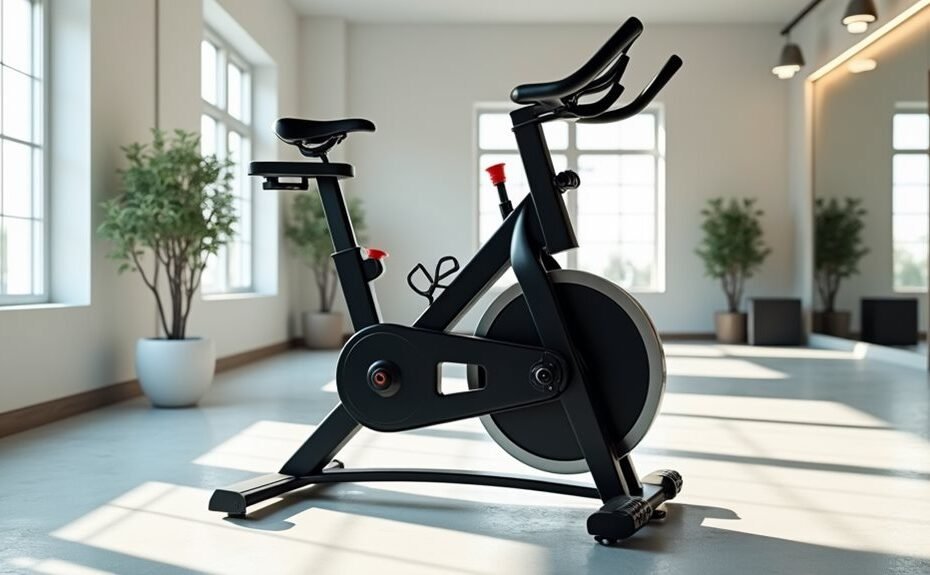I've seen fan bikes change workouts, transform training sessions, and redefine home fitness. As someone who's tested numerous exercise machines over the past decade, I can tell you that fan-based resistance bikes offer a unique combination of simplicity and sophistication that's hard to match. While traditional exercise bikes might leave you wanting more, these air-powered machines respond to your every move with proportional resistance. But before you decide whether a fan bike deserves a spot in your home gym, there are essential aspects about their technology and performance you'll need to think about.
Key Takeaways
- Fan-based resistance bikes use air turbulence through a large fan to create unlimited, automatically adjusting resistance levels.
- Resistance increases naturally with effort intensity, providing consistent and measurable workout data up to 2500 watts.
- These bikes typically feature robust steel construction with transportation wheels and either belt or chain drive systems.
- Built-in HD displays track performance metrics while Bluetooth connectivity enables integration with popular fitness apps.
- Fan bikes offer versatile training options including HIIT, cardio, and full-body workouts with immediate response to user effort.
Design and Build Quality
A powerhouse of engineering, resistance static bikes feature robust steel construction that forms the backbone of their design. I'm particularly impressed by the black powder-coated finish – it's not just for looks, it actually prevents rust and extends the bike's lifespan. The square steel tubing isn't just for show either; it's what keeps you stable during those intense training sessions. The transportation wheels make it easy to move and store the bike when needed. Most quality bikes like the Belt Drive System options run much quieter during operation.
Let me tell you why weight matters here: a heavier frame means better stability. You won't get that annoying wobble when you're pushing hard. I've seen plenty of lightweight bikes shake like leaves in the wind – that's not what you want when you're focused on performance.
The adjustable leveling feet are a game-changer too. Got uneven floors? No problem. Just twist, level, and you're ready to roll.
Trust me on this: the engineering team didn't cut corners. Every weld, every joint, every component is designed for maximum durability. You're looking at a piece of equipment that's built like a tank but performs like a precision instrument. That's exactly what you need for serious training.
Air Resistance Technology Explained
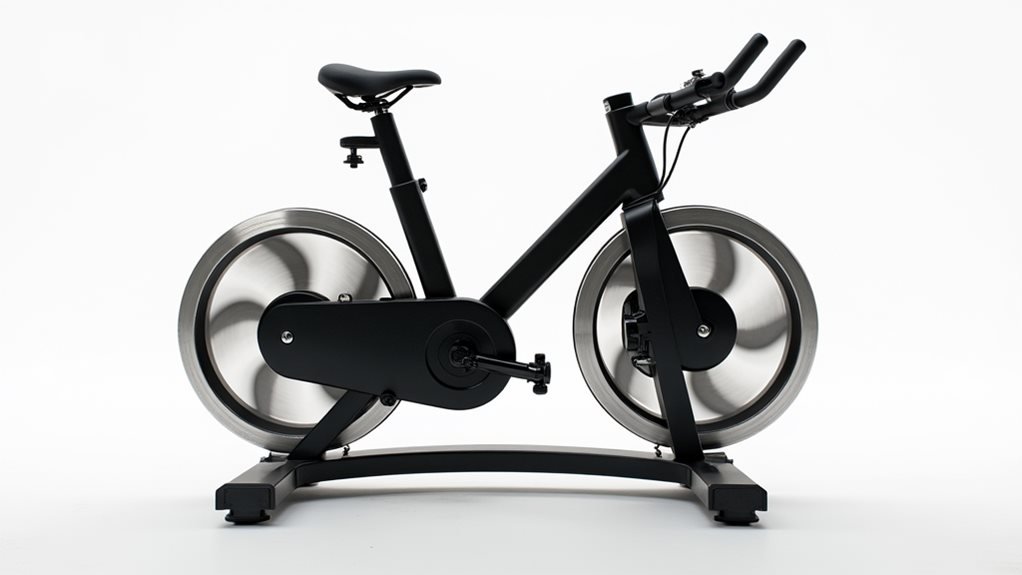
Innovation drives the air resistance system at the heart of these bikes. I'll tell you exactly how it works: there's a massive fan up front that's your resistance machine. When you push those pedals or move those handles, you're spinning that fan against the air itself. It's brilliantly simple and ruthlessly effective. Unlimited resistance levels adjust automatically as you pedal. This design has been used for centuries in stationary bikes.
Let me break down the genius part: the harder you work, the more that fan fights back. There's no fiddling with resistance knobs or pressing buttons – you're getting exactly what you put in, every single time. Push harder, get more resistance. Back off, and it eases up. It's like having a training partner that perfectly matches your effort level.
The physics here are beautiful in their simplicity. That fan's creating air displacement, which generates resistance through turbulence and drag. It's the same principle that makes it harder to run into a headwind, except here, you're creating your own headwind. And trust me, when you're really cranking, that fan's generating enough resistance to humble even the fittest athletes. It's pure mechanical efficiency at its finest.
Moving and Storing Your Bike
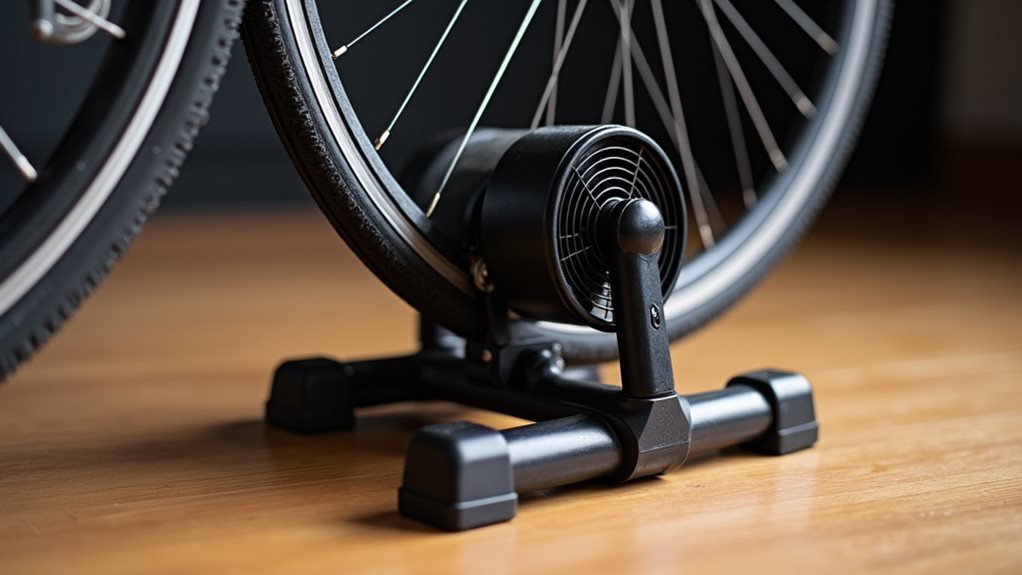
Moving and storing your resistance bike doesn't have to be a workout in itself. I'll show you how to handle your equipment like a pro, whether you've got a 111-pound Titan Fitness Fan Bike or a lighter Concept2 BikeErg. The air resistance system provides smooth and quiet operation while in use.
Let's start with movement. Your bike's equipped with transport wheels and polyurethane tires – they're not just for show. Grab the easy-grip handle (it's 38mm in diameter, perfect for control) and tilt. Those turf-ready wheels will glide across any surface without destroying your floors. No special mats needed. The 10-inch turf tires ensure smooth transport across various surfaces.
Storage is straightforward. Most bikes have a modest footprint – we're talking about 50 inches high and roughly 20 inches wide. You'll need a dry, ventilated space. While these bikes aren't foldable, you can adjust the seat and handlebars to minimize space. Some models can even be stored on their side.
Pro tip: Cover your bike when stored. That powder-coated finish is tough, but why test it? And remember – while you can disassemble components for storage, keep the main frame intact. You'll thank me when it's time to ride again.
Digital Display and Smart Features
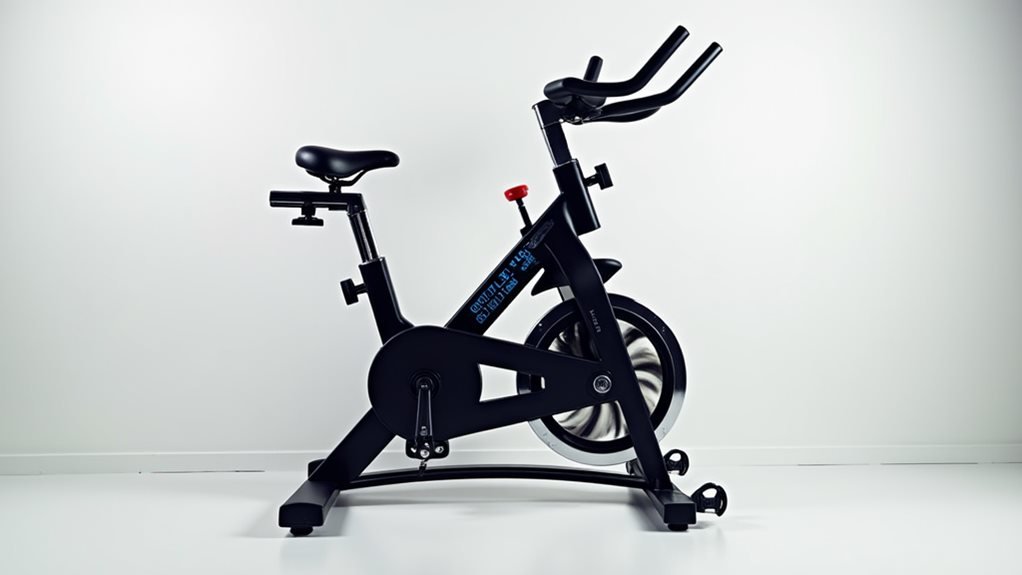
Thanks to modern technology, resistance bikes now come equipped with impressive digital displays and smart features that transform your workout experience.
I'm talking about crystal-clear HD touchscreens up to 22 inches that'll show you everything from your speed to your heart rate while you're crushing those miles. These aren't just pretty screens – they're your gateway to virtual rides and live classes that'll keep you motivated. Many bikes feature 360-degree rotating screens for optimal viewing during workouts. You can easily access customer support through Geek Squad for any technical assistance needed.
Let me break down what makes these bikes truly smart. You're getting automatic resistance control that adjusts in real-time, Bluetooth connectivity for seamless data tracking, and integration with fitness apps like iFIT.
The interface is designed for maximum customization – adjust your seat, handlebars, and workout intensity with a few taps. Want to clip in with SPD pedals? Done. Need a fan to cool down? Just hit a button.
Here's what really matters: these smart features aren't just bells and whistles. They're tools that transform a basic workout into an immersive experience.
Whether you're joining a live class or tackling a virtual mountain climb, you're getting real-time feedback and motivation that pushes you further.
Power Output and Performance
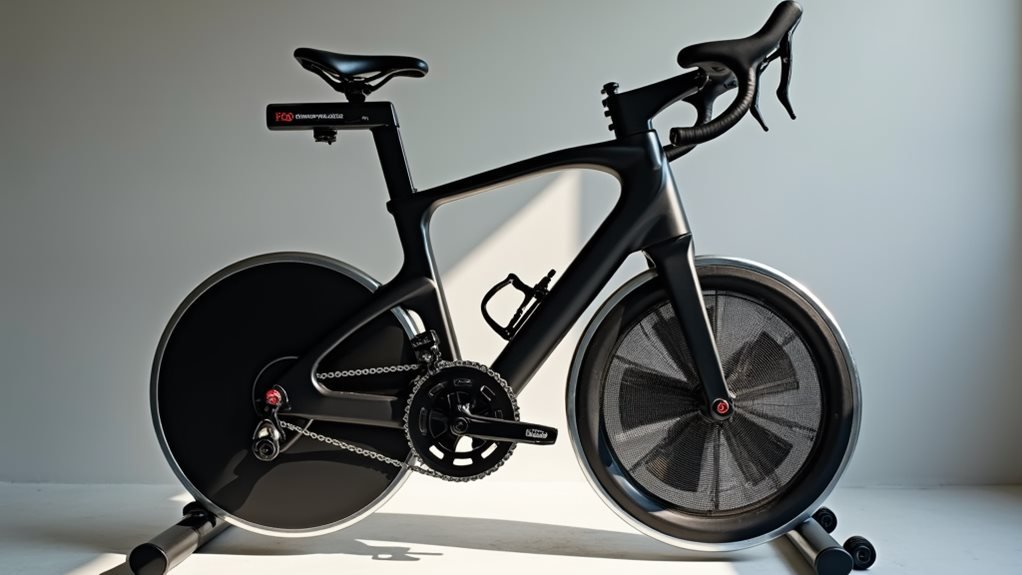
Through advanced power measurement systems, resistance bikes deliver precise tracking of your performance metrics. I'll tell you straight – these aren't your average exercise bikes. With power outputs reaching up to 2500 watts on models like the Wattbike Air, you're getting professional-grade performance monitoring that won't leave you guessing about your efforts. Your strain gauge sensors ensure highly accurate power readings during every session.
Look, if you're serious about training, you'll appreciate how these bikes respond instantly to your input. The fan-based resistance mechanism adapts seamlessly to your effort level, whether you're grinding through an FTP test or exploding into sprint intervals. The high-performance belt drive ensures smooth and consistent motion at any intensity level.
I've seen athletes push these machines to their limits, and they hold up beautifully.
You'll get consistent, repeatable measurements that make tracking your progress a breeze. Sure, some meters like the PM5 on the Concept2 BikeErg mightn't be lab-grade accurate, but they're reliable enough to show your performance trends. Plus, with adjustable resistance levels, you can fine-tune your workouts from gentle recovery spins to all-out HIIT sessions. Trust me, these bikes will match whatever intensity you bring to the table.
Maintenance Tips and Care
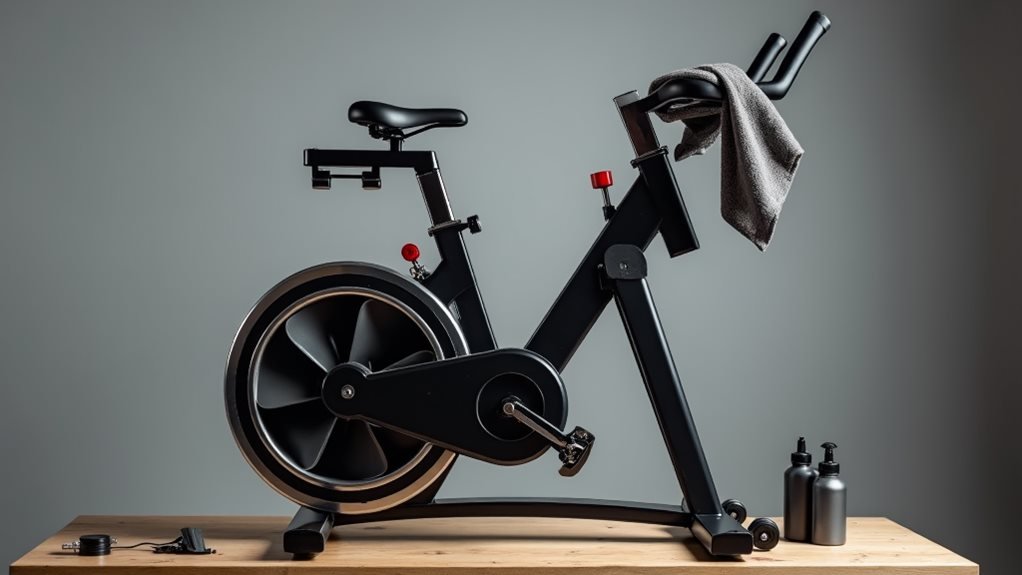
While these bikes deliver impressive performance metrics, they'll only maintain peak output with proper care. I'll tell you exactly what needs to happen daily, weekly, and monthly to keep your bike humming like new.
| Timeframe | Task | Why It Matters |
|---|---|---|
| Daily | Wipe clean after use | Prevents rust, maintains finish |
| Weekly | Check assemblies | Catches loose parts early |
| Monthly | Lubricate components | Reduces wear, extends life |
Listen up – your maintenance rhythm is critical. Daily, you'll need to wipe down that frame with soap and water (on the cloth, never directly on the bike). Weekly, I want you checking for loose parts and those telltale vibrations that spell trouble. Watch those brake pads – they'll tell you when something's off.
Monthly maintenance is where the magic happens. That's when you'll hit every major component with proper lubrication. For belt-driven models, keep it clean and dry. Chain-driven? Check that tension by standing on those pedals at 3 and 9 o'clock. And please, when you hear grinding, don't ignore it – that's your bike begging for attention.
Training Options and Versatility
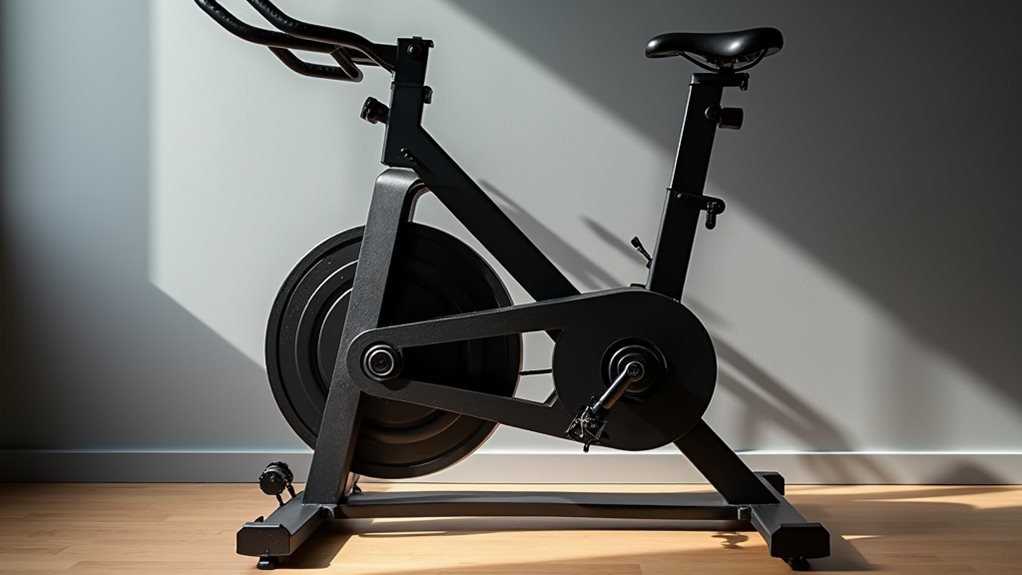
Resistance static bikes offer incredible training versatility, letting you tackle everything from gentle cardio to intense HIIT workouts. I'll show you how to maximize this machine's potential – trust me, it's a game-changer for your fitness goals.
Want HIIT? I've got you covered. Try my favorite: 10 seconds at near-sprint intensity (think 8-10 on the effort scale), followed by 50 seconds at an easy pace (around 4). Repeat this for 10 minutes, and you'll feel like you've conquered Mount Everest. The beauty? No fiddling with resistance settings – just pedal harder when you need more challenge.
Looking for something different? Let's talk options. You can focus purely on cardio by maintaining steady fan speed, isolate upper body work using just the handles, or combine both for a killer full-body session.
I'm particularly fond of ladder intervals – they'll keep your body guessing and your mind engaged.
The best part? Whether you're a complete newbie or a seasoned athlete, you'll find your sweet spot. The machine responds to your effort level, making every workout exactly as challenging as you need it to be.
Comparing Different Models
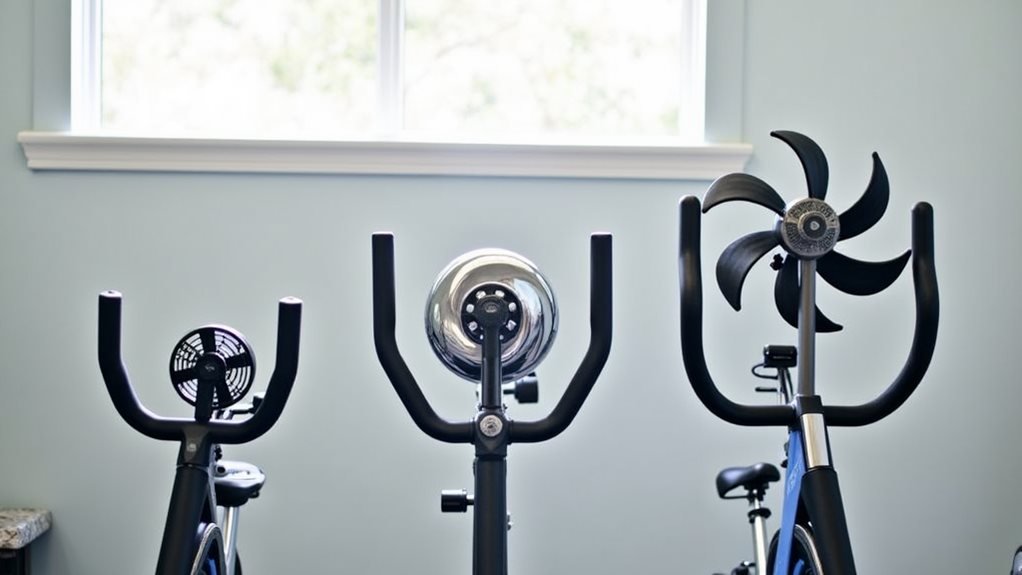
In light of the growing popularity of static bikes, fan-based models stand out from traditional magnetic and mechanical alternatives. I've found the key distinction lies in their unique resistance mechanism – it's all about those fan blades cutting through air. Trust me, it's a game-changer.
Let's cut to the chase: fan-based bikes deliver immediate response to your efforts, unlike their magnetic cousins. You'll notice this instantly when you're doing explosive intervals. The belt-driven system means you won't be dealing with chain maintenance headaches – it's just pedal and go.
I've tested countless models, and here's what separates the good from the great: look for tool-free adjustments and heavy-duty steel construction. You want a bike that's built like a tank but adjusts like a dream. The powder-coated finish isn't just for show – it'll keep your investment sweat-resistant for years.
While some models lack handlebar-mounted resistance controls (you won't need them anyway), they make up for it with rock-solid stability and whisper-quiet operation. Bottom line: if you're serious about indoor training, a fan-based system deserves your attention.
Cost and Value Analysis
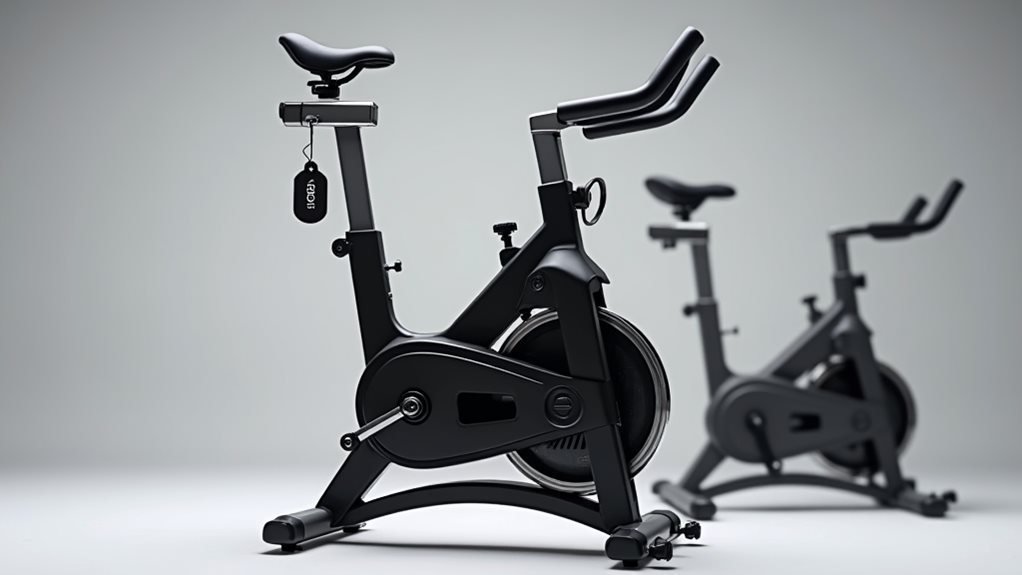
Today's fan-based resistance bikes span a wide price spectrum, from basic $150 models to premium options exceeding $2,500. I'll tell you straight up – you get what you pay for in this market. Entry-level models deliver fundamental functionality, while premium options pack advanced features that'll make your training sessions more effective and enjoyable.
Let me break down the key value propositions I've observed across price points:
- Basic models ($150-$500): Perfect for beginners, offering essential features without bells and whistles – they'll get the job done if you're just starting out
- Mid-range options ($900-$1,000): The sweet spot for serious enthusiasts, delivering durability and smart features like tool-free adjustments
- High-end models ($1,500-$2,500): Integration with training apps, advanced metrics, and superior build quality make these worth it for dedicated athletes
- Premium bikes ($2,500+): Built like tanks with pro-level features – if you're training daily, these are your best long-term investment
I've found that spending more initially often saves money in the long run through reduced maintenance costs and better durability. Remember, fan-based systems typically require less upkeep than traditional resistance methods.
Frequently Asked Questions
Can Pregnant Women Safely Use Fan-Based Resistance Bikes?
I recommend fan-based bikes during pregnancy, but you'll need your doctor's approval first. They're low-impact and safe when you maintain proper form and monitor warning signs.
Does the Fan Create Enough Airflow to Cool You While Exercising?
Playing it by ear, I'd say the airflow will cool you down during exercise, but it's not a complete solution. I often suggest having an extra fan nearby for particularly intense workouts.
How Loud Is the Fan Noise Compared to Regular Conversation?
I'd say fan bikes are louder than regular conversation. While you're talking at about 60 decibels, the fan noise can get much higher when you're pedaling intensely.
Are Replacement Parts Readily Available if the Fan Blades Break?
You'd think fan blades would be hard to find, but I can easily get them from official manufacturers or online retailers like Sears PartsDirect. They offer both OEM and aftermarket options.
Can Children or Shorter Adults Comfortably Use These Bikes?
I can confirm that children and shorter adults can comfortably use these bikes since they typically offer adjustable seats, handlebars, and pedal positions to accommodate various heights and body types.
